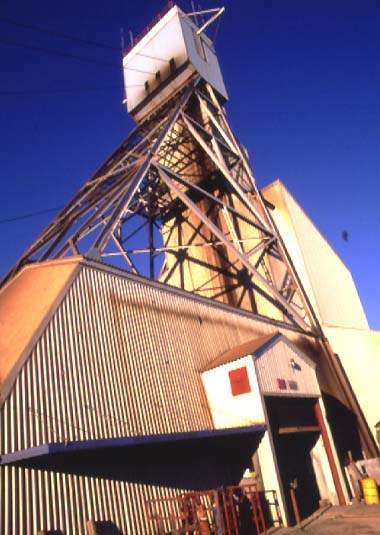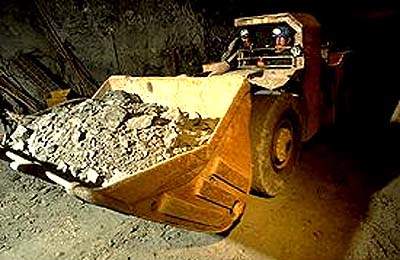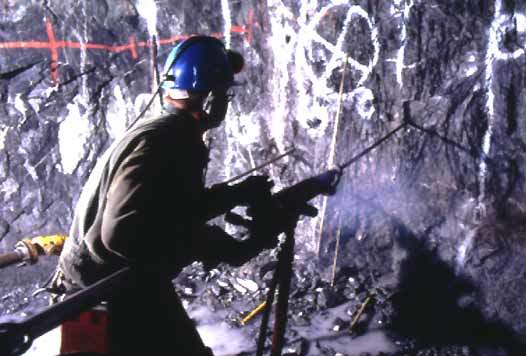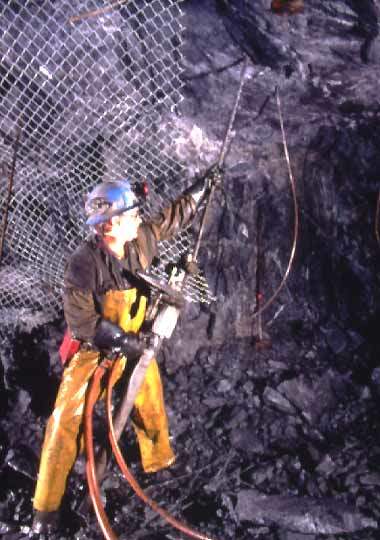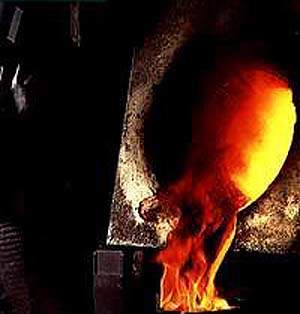In continuous operation since 1949, since when it has produced over 11Moz of gold, the Campbell underground gold mine is located at Balmertown, northwestern Ontario. Formerly wholly owned by Placer Dome Inc., the mine is now owned by Goldcorp Inc., following Placer’s take-over by Barrick Gold Corp. in early 2006. Barrick subsequently sold several former Placer properties to Goldcorp, especially where there was the potential for operational synergies between neighbouring mines.
Goldcorp has now merged Campbell with its existing Red Lake mine as one operating unit, with the combined operation expected to have an output of around 1Moz/y of gold by 2008.
GEOLOGY AND RESERVES
Campbell is located in the eastern part of the Red Lake Greenstone Belt, in the Birch Lake/Uchi Lake sub-province of the Canadian Shield. The auriferous zones occur on the eastern border of a major archean tholeiitic volcanic complex. The gold occurs as either free gold or is in sulphide minerals, mainly arsenopyrite, pyrite and pyrrhotite. A minor amount of silver occurs with the gold.
As of December 2005, proven and probable ore reserves stood at 5.5Mt grading 8.2g/t and containing 1.45Moz of gold. Measured and indicated mineralisation contained a further 1.83Moz.
MINE LAYOUT AND DEVELOPMENT
Mine access is through two separate shafts – No.1 shaft is a four-compartment shaft sunk to below 27 level (1316m below surface). The Reid shaft opened up more than 600 vertical metres of new ground below 27 level, and is now the main ore hoisting shaft.
The mine is track-based with full haulage facilities on every level. Electric LHDs and hydraulic longhole drills are used in high-tonnage areas. Mining methods have evolved from shrinkage stoping through cut-and-fill and finally to longhole mining. Longhole mining includes sub-level and crown pillar operations mine-wide and accounts for 75% of production with cut-and-fill producing another 2%. The remaining 23% is from development.
Mechanised cut-and-fill commenced in 2001 and will be preferred over conventional longhole where feasible. Pastefill totally replaced hydraulic fill in the final quarter of 2000 to speed mining.
ORE PROCESSING
Run-of-mine ore is crushed underground, hoisted to the surface, then re-crushed to –10mm before grinding in a closed rod mill/ball mill/cyclone grinding circuit.
Approximately 48% of the gold is recovered by gravity separation, Knelson concentrators being used to recover free gold and a small portion of the sulphide minerals. The free gold is separated from the sulphides on shaking tables. The remainder of the gold reports to the sulphide flotation feed. The flotation concentrate is thickened to about 55% solids before treatment in an autoclave operating at 2,100kPa and 190–195°C. Oxygen sparging is used to convert the sulphides to sulphates and contained arsenic to ferric arsenate. The oxidised slurry is neutralised with lime before leaching in an eight-stage oxide cyanidation circuit. In 2000, an oxygen distribution system was added to the leach circuit to increase recovery. Gold-bearing solutions are recovered by three filters.
Pre-treatment thickener overflow passes through pressure filters to remove any solids. The solution is mixed with carbon-in-pulp tailings in a four-stage neutralising circuit, which raises the pH to 8.5 to precipitate heavy metals. The flotation tailing is leached in cyanide for approximately 24 hours followed by six hours of carbon-in-pulp processing. The gold in solution is absorbed onto the carbon. Loaded carbon is stripped using a caustic solution. Solutions from the oxide leach and the carbon strip circuits are combined and clarified in a hopper clarifier followed by pressure filtering. A Merrill-Crowe zinc precipitation system is used to recover the gold, which is collected in a plate-and-frame press. In 2000, a calcine feed circuit was installed and wetland cells were constructed for full-scale operation in 2002.
REFINING
Gold refining is carried out on site, with gravity concentrates and zinc precipitates being refined separately. Each is mixed with varying amounts of fluxes (nitre, borax, silica, fluorspar and manganese dioxide), placed in a furnace and heated to temperatures greater than 1,000°C. The impurities oxidize and combine with the fluxes which separate from the bullion. The bullion, containing up to 93% gold, is then poured into doré bars.
PRODUCTION
In 2005, 440,000t of ore grading 15g/t were milled at a 96% recovery to yield 209,200oz of gold, virtually the same as in 2004. Output in 2006 was then expected to be around 200,000oz.
FUTURE DEVELOPMENT
Goldcorp’s Campbell complex is developing the deep DC ore zone, with the Campbell and Red Lake mines being linked at depth through a new shaft system that has recently been completed. Sunk at a cost of C$196m, the new 1,924m shaft is scheduled for commissioning during 2007, and will increase hoisting capacity, reduce access time and help cut costs. The merged operations will also be able to mine lower-grade ores profitably as a result of their lower combined costs.

